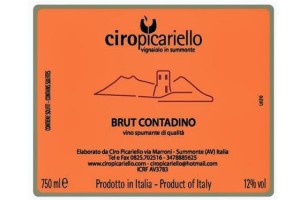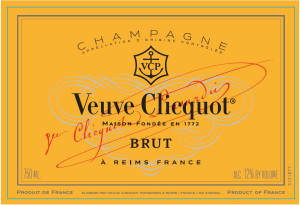Update January 23, 2014: The Drinks Business reported today that Veuve Clicquot denied filing suit against Ciro Picariello and instead contends that the Champagne company contacted the Italian sparkling wine producer to note the “similarity” of the labels and see if there is any way Ciro Picariello’s label could “evolve” to avoid the risk of association between Veuve Clicquot and Ciro Picariello. See Veuve Clicquot Denies Lawsuit Over Label.
Yesterday, Wine-Searcher.com confirmed that the renowned Champagne house, Veuve Clicquot, is suing a small Italian sparkling wine producer over its label. See Veuve Clicquot Sues Italian Producer Over Label; see also Veuve Clicquot to Sue Winery Over Labels. Ciro Picariello is a family-owned winery in Campania, Italy that produces “just 3,500 bottles of its fiano-based Brut Contadino each year.” Veuve Clicquot Sues Italian Producer Over Label. The label, pictured left, is a very distinct orange color, similar to the shade of a Jack-o-Lantern.
Veuve Clicquot is known for its bright mustard yellow labels, pictured below, on most of its Champagne products, including its brut. It is also the signature color of many of the company’s products, including those that appear at Veuve Clicquot-sponsored events around the world. The company registered this color, known as Pantone 137C, as a trademark with the European Community. Id. The maison is the second-largest Champagne house in the world and produces up to 18 million bottles of Champagne each year. See Golia Che Teme Davide: Il Colosso Dello Champagne Veuve Clicquot fa Causa al Produtorre Irpino Ciro Picariello. Meanwhile, Ciro Picariello produces about 50,000 bottles of wine each year in the Avellino region of Campania. See Veuve Clicquot Sues Italian Producer Over Label, supra.
Irrespective of how different the colors of these two labels are, the LVMH-owned Veuve Clicquot “took exception to the label and has instructed its lawyers to take action against Ciro Picariello claiming the Brut Contadino label is too similar to its own Yellow Label Champagne.” Id. The Champagne house is concerned that the orange label of Ciro Picariello’s sparkling wine could cause consumer confusion with its Reims-based Champagne product, thus causing economic damage to Veuve Clicquot.
From a U.S. legal perspective, there are many factors that could count against finding in favor of a likelihood of confusion or trademark infringement, ranging from the different color scheme, different brand names, differing fonts and logos, to the distinct wine regions and perhaps even different method of production. However, Veuve Clicquot is quite powerful in the sparkling wine and Champagne world, and it likely has great resources to fight a continuous battle. Further, Veuve Clicquot’s mark strength or fame in light of the similarity of the goods could be a significant weight in favor of the maison. But again, this is from a U.S. perspective—the fate of this suit almost certainly lies within the European Community.
Interestingly, “[s]upporters of Ciro Picariello have taken to social media to protest at the legal action being taken against the Italian winery, creating the Twitter hashtag – #boicottalavedova (‘boycott the Widow’).” Id. Additionally, many public comments on blog posts, including those on the Wine-Searcher.com post and GrubStreet.com, indicate communal distaste for Veuve Clicquot’s suit.
Images courtesy of TTB Public Label Database and Veuve Clicquot Sues Small Winemaker Over Label That Looks Nothing Like Its Own.
For more information on wine or alcohol law, trademark, or international trade, please contact Lindsey Zahn.
DISCLAIMER: This blog post is for general information purposes only, is not intended to constitute legal advice, and no attorney-client relationship results. Please consult your own attorney for legal advice.


Comments (5)